OSAMU TEZUKA, MANGA AND ANIME
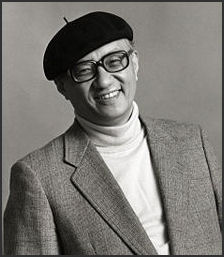
Osamu Tezuka (1928-1989) has been called “the god of manga? and the “founder of anime.” In his life he created a stable of memorable characters and stories and did more than anyone else to make manga and anime what they are today. Tezuka “was a true genius” manga expert Frederick Schodt said. “But like some geniuses you read about, he also had an almost childlike quality,”
In his 42 year career, Tezuka created characters like Astroboy and Kimba, first for comics books and then for animated television shows. He drew about 150,000 pages of art work, 300 manga volumes and about 7,000 works with nearly 1,000 characters. About 150 of his works were made into animated, mostly black and white, movies. Around 60 were made into series.
Tezuka was a skilled artist and innovator. A great fan of Disney and Charlie Chaplin, he was determined make manga as lively as the movies and is credited with developing a style that used different “camera angles” that helped the action flow and move across the pages as in a movie, with the characters often ignoring their frames and leaping out of the borders. Even when the material was dark the characters were cute.
Robert Reed wrote in the Daily Yomiuri,”As a manga artist, Tezuka certainly needs no introduction in Japan. Here, he is commonly called "manga no kamisama" (literally the "god of manga") and is credited with almost single-handedly elevating comics to a serious art form. With what are now classic works such as Tetsuwan Atom (Astroboy), Jungle Taitei (Kimba the White Lion) and Hi no Tori (Phoenix) in the 1950s and 60s, he raised the bar in a way that established the genre's credibility and laid the foundation for the immense worldwide popularity of Japanese manga today...Almost all Tezuka works share a warm humanism and concern for the value of life. He was a doctor turned manga artist and philosopher, a man well versed in both Eastern and Western culture” [Source: Robert Reed, Daily Yomiuri, May 13, 2011]
Book “Astroboy Essays” by Frederick Schodt offers a good behind the scenes look at Tezuka’s life and offer insight into his creative genius. Good Websites and Sources: Tezuka in English tezukainenglish.com ;Osamu Tezuka, The Father of Manga tezukasite.tripod.com ; Official Site tezukaosamu.net ; Osamu Tezuka Manga Museum tezukaosamu.net ; Internet Movie Base imdb.com ; Anime News Network animenewsnetwork.com ;Official Site tezukaosamu.net ; Official site of Astroboy Movie astroboy-themovie.com ; Astroboy Clips and Streams hulu.com/astro-boy ; Black Jack Basics tezukainenglish.com ; Osamu Tezuka Manga Museum is between Osaka and Kobe in Takarazuka in Hyogo. Websites: JNTO article JNTO ; Site about the museum digilander.libero.it
Links in this Website: MANGA Factsanddetails.com/Japan ; POPULAR TYPES OF MANGA Factsanddetails.com/Japan ; POPULAR MANGA AND FAMOUS MANGA ARTISTS Factsanddetails.com/Japan ; MANGA FANS AND COSPLAY IN JAPAN AND ABROAD Factsanddetails.com/Japan ; OSAMU TEZUKA, MANGA AND ANIME Factsanddetails.com/Japan ;ANIME Factsanddetails.com/Japan ; ANIME FILM AND TELEVISION SHOWS Factsanddetails.com/Japan ; HAYAO MIYAZAKI ANIME Factsanddetails.com/Japan ; MODERN JAPANESE FILM INDUSTRY Factsanddetails.com/Japan ; MODERN JAPANESE FILMMAKERS AND FILMS Factsanddetails.com/Japan ; MEDIA, RADIO, NEWSPAPERS AND TELEVISION IN JAPAN Factsanddetails.com/Japan ; TELEVISION PROGRAMS IN JAPAN Factsanddetails.com/Japan ; CHILDREN’s TELEVISION SHOWS IN JAPAN Factsanddetails.com/Japan ;
Good Websites and Sources on Manga: Wikipedia article Wikipedia ; Manga.com manga.com ; Free Manga using Scanned Pages onemanga.com ; Manga Fox mangafox.com ; How to Draw Manga howtodrawmanga.com ; Essay on Manga and Anime aboutjapan.japansociety.org ; Krazy World of Manga, Anime and Video Games ; Ultimate Manga Guide (last updated 2004) users.skynet.be/mangaguide ; Rei’s Manga and Anime Page (last updated in 2005) mit.edu/people/rei/Anime ; Manga Video manga.com ; Comic Yamasho Stores comic-yamasho.jp-stores.com ; Kyoto International Manga Museum kyoto-international-manga-museum
Books: “Manga Manga! The World of Japanese Comics and Dreamland Japan”; “Manga! Manga!”by Fred Schodt; “Dreamland Japan: Writings on Modern Manga” by Frederick L. Schodt (Stone Bridge Press); “Adult Manga” by Sharon Kinsella (Cuzon Press, 2000); “Manga: Sixty Years of Japanese Comics” by Paul Gravett (Laurence King Publishing, 2004); “Manga: The Complete Guide” by Jason Thompson (Dek Ray); and “One Thousand Years of Manga” by art historian Brigitte Koyama. Related books include “Japanamerica” by Roland Kelts (Palgrave Macmillian, 2007) and “Encyclopedia of Japanese Culture” by Mark Schilling. “Millennial Monster”by Prof. Anne Allison is about the fantasies behind toys, games, anime and manga.
Frederik Schodt was awarded the Japanese government’s Order of the Rising Sun.
History of Manga: A History of Manga dnp.co.jp/museum ; Manga Gaku matt-thorn.com/mangagaku ; Brief History of Manga comicreaders.com ; Tokyo Manga and Anime Shops : Nakano Broadway is a shopping street in Nakano Ward that houses many shops selling items related to pop idols, manga and anime characters. Tokyo Character Street is located on the Yaesu side of JR Tokyo station. It is an 80-meter-long underground street with 15 shops offering hundreds items bearing likenesses of anime figures like Doremon and Ultraman and new characters like NHK mascots Zoomin and Charmin and Monkey D. Luffy from “One Piece” as well characters like Totoro form Miyazaki’s Studio Ghibli. Manga Magazines and Publishers: Shonen Jump shonenjump.viz.com ; Viz Media www.viz.com ; Tokyopop tokyopop.com
Good Anime Websites and Sources: Crunchyroll crunchyroll.com . Crunchyroll is an Internet portal for anime downloads that began as a free fan file-sharing site and grew into a for-profit site that charges users fees that go to the producers of the anime. Free Anime Streams on Watch Anime watchanimeon.com ; Free Anime Streams on Zomganime.com zomganime.com ; Wikipedia article Wikipedia ; Tokyo International Anime Festival tokyoanime.jp ; Anime News Network animenewsnetwork.com ; Anime Books: “Anime: from Akira to Howl’s Moving Castle” by Susan J. Napier (Palgrave, 2001); “The Anime Companion” by Gilles Poitras (Stone Bridge Press, 1999); “Anime Revolution” by Ian Condry, a Harvard professor; “Rough Guide to Anime” by Briton Simon Reynolds.
Articles and Essay on Anime: Essay on Manga and Anime aboutjapan.japansociety.org ; Useful Filmography on Anime aboutjapan.japansociety.org ; Essay on Teaching Anime aboutjapan.japansociety.org ; Essay on Dawn of Anime aboutjapan.japansociety.org ; Anime Blogs Random Curiosity randomc.animeblogger.net ; The Anime Blog theanimeblog.com ; Japan Underground Blog hamblogjapan.blogspot.com ; Anipike anipike.com/ ;
Places That Sell Anime Right Stuf Anime Superstore rightstuf.com ; Anime Corner animecornerstore.com ; Anime Nation animenation.com ; Krazy World of Manga, Anime and Video Games; Japanese, Chinese and Korean CDs and DVDs at Yes Asia yesasia.com ; Japanese, Chinese and Korean CDs and DVDs at Zoom Movie zoommovie.com ; Animax is a satellite channel that specializes in anime. It debuted in 1998 and claims 41 million viewers in Japan and is broadcasts in 46 other countries. Among the classic that are featured are “Dragonball Z”, “Mobile Suit Gundam”, “Astroboy”, and “Lupin III”. Animex is owned by Sony. The Cartoon Network exclusively airs Japanese anime after midnight.
Osamu Tezuka's Life
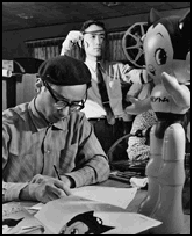
Tezuka was born in Toyonaka near Osaka and brought up in Takarazuka in Hyogo prefecture. As a child he liked collecting and drawing insects, filling notebooks with meticulous drawings of butterflies and other insects, and was inspired by films and the all-female Takarazuka Revue. He received a degree in medicine and did medical drawings before becoming a cartoonist.
Tezuka was both traumatized and stimulated by his experience in World War II. He lost many friends in the war and was left with a strong dislike for technology. After the war he moved to Tokyo. He got his start as an illustrator by siting through Disney films like “Bambi” and “Snow White” with a sketch pad in hand and selling drawings he made without Disney’s knowledge or permission.
His first work, “New Treasure”, published when he was 19, sold a half million copies. Other early works include the “Lost World” (1946) and “Metropolis” (1948), inspired by the Fritz Lang film and “Jungle Emperor Leo” (1956, Kimba).
By the early 1960s his successes in comic books and cartoons had made him a millionaire. After that Tezuka devoted a lot of time and energy to his animated film company, Mushi Productions. In 1973, the company went bankrupt and his family had to move into a small rented house. His career was revived with the success of the film version of “Hinotori” in 1980 and he was able to move into a new, lager home.
Osamu Tezuka at Work
Tezuka worked in an eight tatami-mat room on the second floor of home in Higashi-Kurume, western Tokyo, where he lived before 1980. He used a regular steel office desk for much of his career. In it he kept his favorite pair of glasses, notebooks and a vintage stethoscope. When he was he was really busy he liked to pull out a futon and draw while lying in his stomach.
Tezuka’s son Makoto told the Yomiuri Shimbun, “When my dad was young, he wasn’t very picky about his tools — he even drew on mikan boxes. I think the simplicity of his beloved desk shows that he liked his life without being hung up on his tools.”
Tezuka was an incredibly hard worker. He often shut himself into a room when he worked so even his family didn’t see him . He spent so much of his time in his studio he had little contact with his own children even though children were his primary audience. Tezuka liked to work with the television going and often only slept two hours a night. He was working on three works at once when he died in 1988.

Tezuka's characters celebrate Tezuka's 80th birthday in 2008
Osamu Tezuka's Manga
Tezuka is credited with giving manga a cinematic style. He used a combination of framing, sequences and juxtaposition and even written sound effects to give print media a dynamic- quality that it otherwise lacked,
Frederick Schodt wrote, “the main thing that Tezuka did, I think, is that he took the American comic book format and basically decompressed it...So where in traditional American comic books you might have one scene that’s depicted with one page, Tezuka would use 10 pages or 20 pages or even 30 pages...Some of Tezuka’s stories became very long, several hundred even thousands of pages long, which enabled him to do things more like what writers and film directors do.”
Schodt, who translated some of Tezuka’s work into English, also said, “Visually, you can see that a lot his influences came from American animators, such as Walt Disney and Max Fleisher. But in terms of content, a lot of his influences came from Russian literature. Tezuka was a big fan of Russian literature.” On the Russian-inspired pieces Schodt said, “A lot of these designs are also directly out of theater. If you look at the stage design, the background, and you read these manga pages, you can see that this was taken right out of the stage design and put right in the page.”
The big round eyes so common in manga are said to have originated with Osamu Tezuka. Some have suggested he was inspired by Betty Boop.
Astroboy
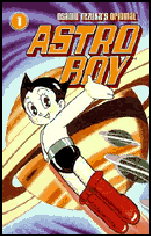
“Tetsuwan Atomu” (literally "Atom with Iron Arms" or "Mighty Atom") in the opinion of many was the first true manga and anime character. Known as Astroboy in the West, he was a youthful super-hero robot who wanted to be a real boy.
Astroboy is greatly loved in Japan. One fan told the New York Times, “Japanese people imagine a world where robots live with people. The idea comes from Astroboy.” Among his fans in the United States are Gene Simmons in the rock group Kiss who said that Astroboy inspired him and gave him dreams.
Some of the researchers in the robotics labs of Sony and Honda, where the robot dog Aibo and human robot Asimo were developed, have said their managers told them to “develop an Astroboy.” An engineer who helped create Asimo told the Asahi Shimbum, “What we want to is to make Asimo an stro Boy come true in the next 30 years.
Website: http://astroboy.jp
Astroboy’s Features
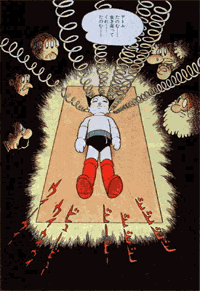
Astroboy's birth Astroboy stands 1.35 meters tall. He is shirtless and wears black shorts with a green belt and red boots. He has a unique polished double spike haircut that looked almost the same when viewed sideways as it does when viewed from the front. When he walks he makes a distinctive “scritch scritch” noise.
Astroboy has seven special features: 1) 100,000 horsepower engine strength; 2) searchlight eyes; 3) rocket jets in his boots and arms; 4) laser fingertips; 5) super hearing that magnifies sound 10,000 times: 6) machine guns in his shorts; and 7) a built-in translating computer that allowed him to understand 60 languages.
What set Astroboy apart from robots that preceded him is that he has feeling and morals. Maureen Donovan, a professor at Ohio University, told the Asahi Shimbun, He is “a robot that has emotions that human beings have lost track of. He helps people, he fights evil, yet he makes mistakes. He is not completely mechanical.”
Matsuo Ohno was the sound engineer who come up with futuristic sounds for the Astro Boy TV show in the early 1960s. His experimentation with hitherto nonexistent sound effects — much of it manipulated open reel-to-reel tape recorders — also made him a pioneer in electronic music. Ohno is still alive. He now spends much of his time working with developmentally disabled adults, something he has long been interested in.
Astroboy’s Life
According to the comic series, Astroboy was born on April 7, 2003 in a laboratory in the Takadanobaba district of Tokyo. He was created by Professor Temma, an inventor with a white Afro and long bulbous nose, who was torn apart with grief over the death of his human son. When the professor realizes that Astroboy will never grow up and truly replace his son he sell him to a robot circus, where he is rescued by Dr. Ochanpmizu, who raises him and acquaints him with his powers.
Astroboy’s lives in a placed called Metro City. In his time, cars can fly, people can travel in time and robots do all sorts of things.
Astroboy had a kind heart and fought for peace and justice and friendly relations between robots and humans. In a typical episode the energy robot starts running amok. The humans want to destroy it but Astroboy arrives on the scene and appeals to the robot’s heart and convinces it to stop destroying everything in sight.
Astroboy as a Manga and Anime Character
“Tetsuwan Atomu” was dreamed up in the late 1940s by Tezuka and first appeared in 1951 in manga comic books as a secondary character. He was so popular that he was give his own manga in 1952 and became the first manga hero to be featured in a full-length television series. In the original 30-minute cartoon, first shown in January 1963, he was black and white. Astroboy came to life while Japan was rebuilding after World War II and for many he was inspiration for the future. Astroboy came to the United States in 1963.
The original “Astro Boy” manga ran in the comic Shonen from 1951 to 1968. The opening pages of each month’s installments were often carried in the magazine itself while the rest of the story was found in supplementary booklets of a different size. When the series was released in book form, Tenzuka, always the perfectionist, redrew some scenes and edited the text. Sometimes entire episodes such as the birth of Astro Boy’s sister Uran and the death of his younger brother Kobaruro were removed. The entire Astro Boy manga series was reissued in 2009. It came to 6,500 pages, and was released in six boxes, each which sold for about $150.
The show ran in Japan for 193 episodes, ending in December 1966, capturing 30 percent of the viewing audience when the show was at its peak. A second series, in color, ran for 52 episodes from October 1980 to December 1981. The original show ran in the United States and Australia and other places with a few changes. For a while it was the highest rated syndicated show in the United States. Reruns continue in numerous languages around the world.
Tezuka worked in Takadanobaba (where Astroboy was born) from 1976 to 1988. Suspicious of technology, he originally conceived of Astroboy as being a robot who found his life sad and absurd because he wanted to be human. Tezuka was very upset when her was transformed into a heroic figure that glorified science and technology. He intended for Astroboy to be a warning of technology’s dangers as well as a commentary on discrimination, with the robots being discriminated against by humans.
Rebirth of Astroboy as a Manga Character and Hollywood Star
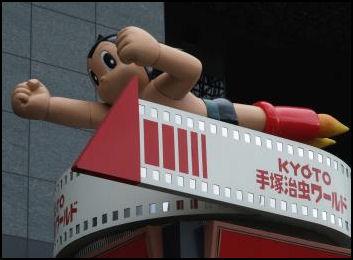
Astroboy at a station sign On the real date of April 7, 2003 — the date that Astroboy was born in the manga series — more than 1,000 people showed up at the Osamu Tezuka Manga Museum in Takarazuka in Hyogo to watch Astroboy being born. In other places the event was marked with fireworks, costume parties and the unveiling of a $1 million diamond- and ruby-studded likeness of the robot boy in a Tokyo department store. To mark the event on television a new 50-episode series of Astroboy, with flashier graphics, was released.
Astroboy manga and merchandise continues to sell well. Some 4,000 products from 80 different companies are marketed. These included “super absorbent” paper towels and “100,000 horsepower” natto (fermented soybeans) and Astroboy children’s underwear and women’s lingerie..
The film “Astro Boy” is directed by David Bowers, a British animator who learned his craft at Nick Park’s Aaedman Animation, the source of “Wallace and Gromit”. Filled with luscious and shiny colorful 3D animation, the film is set in a city that looks like the Jetson’s Orbit City at a time when robots are resentful about their second class status. Astro Boy is created by a scientist who lost his son and injects some of his DNA into Astro Boy. The scientist ultimately abandons the young robot who is then found on a rubbish heap by another scientist who takes in orphaned robots.
On the “Astro Boy” film Bower said, “The tendency of superhero movies these days is to go very very dark. There are certainly dark elements in the “Astro Boy” movie. But at the same time...I wanted “Astro Boy” to be optimistic.”
Bowers also said, “Makoto Tezuka and Tezuka Production have been really instrumental and helpful in making sure that the Astro Boy movie — although it’s a little updated and it’s a little reimagined — is certainly within the bounds of what a Astro Boy move should be.”
The company that is making the Astroboy film made the Hollywood version of Godzilla and that made people associated with Astroboy nervous In the end a deal was made in which Tezuka Productions gave final approval of Astroboy’s look and had the rights to make revisions at three stages in the script making and shooting process. Their share of future earnings is also quite large.
Other Osamu Tezuka Characters
.gif)
Leo and Princess Sapphire “Jangura Taitei” (literally "Great Emperor of the Jungle") is the second most well known Tezuka character. Known as Kimba, the White Lion in the West, he was popualr with American kids in the 1960s and 70s. . Many Japanese feel that Walt Disney's “The Lion King” was plagiarized or at least borrowed shamelessly from “Kimba”.
Tezuka created his share of adult-toned gekiga narratives that explored topics such as crime, society and religion. He also did a manga version of Dostoevsky’s “Crime and Punishment” and a drama called “Tell Adolph”.
Other characters included “Hinotori” (‘space Fire Bird 2772"), “Cyborg 009, Gatchaman” (“Battle of the Planets”), “Mu” (“MW”), “Metoroporisu” (“Metropolis”), the dashing, gender-bending “Princess Sapphire” (1953), “Neo Faust” (1988). He considered “Hi no Tori” to be his greatest achievement. In the 1970s he did a nine-volume manga version of the Buddha story with a lot of characters and adventures that are not found in the classic Buddha tale.
Among the minor characters in Tezuka’s huge body of work are Hyakkimaru in the manga “Dororo”, a teenager who aims to get his body back after his father, a power-mad samurai, sold pieces of his son when eh was unborn to 48 demons. The story starts with the boy armless and lacking ears and eyes, but possessing swords for prosthetic arms. Progressively he wins his body back after successive battles with the 48 demons
Tezuka’s characters live on in Tezuka Productions, a company launched by Tezuka in 1968 and now has earnings measured in the tens of millions of dollars.
Black Jack
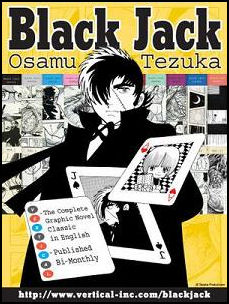
“Black Jack” by Osamu Tezuka was a popular series that ran in Shukan Shonen Champion from 1973 to 1983, featuring the dark hero Black Jack, an unlicensed surgeon who can cure people of most anything as long as they pay his outrageously high medical fees. The series featured life and death situations and E.R.-like operation scenes. Jacks's arch enemy was Dr. Kiriko, who among other things practiced euthanasia for hire. Some regard Black Jack as Osama Tezuka masterpiece. The series has recently been brought back as a movie made by Tezuka’s son Macoto Tezuka.
Black Jack helps people with severe frostbite, cancer radiation burns and earthquake injuries. He is especially good at reattaching severed limbs and transplants, once even successfully performing a brain transplant. But that doesn’t mean he is perfect. Patients sometimes die at the operating table, including people he cares about deeply.
A typical Black Jack story begins with a woman near death’s door desperately in need of an operation that only Black Jack can perform. Jack is available but refuses to begin unless he is paid $300,000 up front, a sum the woman’s poor son has a hard time coming up with.
It is not always clear what Black Jack’s motivations are. Although he is widely accused of being greedy he does occasionally perform operations for free to patients in need. In the case of the $300,000 operation above it not clear whether he is motivated by a desire to help the woman or simply is so greedy he is willing to enslave the son in debt rest of his life.
Tezuka’s Buddha
Osamu Tezuka's late masterpiece, “Buddha” , is a 14-volume manga series that the artist penned over a 10-year period from 1972 to 1983 and surely intended as one of his life's works. Robert Reed wrote in the Daily Yomiuri, “Although the Buddha series may be less known to foreign audiences, it is a favorite among many true Tezuka fans in Japan and has recently won due recognition abroad among serious manga fans — it received the Will Eisner Comic Industry Award for Best U.S. Edition of Foreign Material in 2004 (Vols. 1-2) and 2005 (Vols. 3-4) as the English-language volumes of Buddha were released in the United States by Vertical Inc. (with mirror images of the original to read from left to right). In 2011 it was the subject of the Tokyo National Museum’s first exhibition about a manga. The exhibition was entitled "Buddha: The Story in Manga and Art." [Source: Robert Reed, Daily Yomiuri, May 13, 2011]
The manga covers the important periods of the Buddha's life: his past lives, his birth, marriage and time of anguish, as well as his departure to become a monk. It also covers his austerities, enlightenment, sermons, meditation and pilgrimage, and finally his passing into Nirvana and his burial. “The overtly religious subject matter of the Buddha manga may make it appear to be something of an anomaly among Tezuka's works,” Reed wrote. “Clearly the artist himself did not see it that way, however: Buddha is Tezuka's own generously fictionalized version of the story of the life of the prince Siddhartha and his transformation into the Gautama Buddha. To it he brought the same genius for storytelling, character development and interesting visual devices that make all his work so compelling.”
“Buddha” was created “amidst the spiritual searching of postwar Japan and throughout the second half of the 20th century, when many Japanese artists turned to Buddhism as a source of answers and artistic inspiration. The internationally renowned print artist Shiko Munakata and the Nihonga painter and long-time president of the National University of the Arts, Tokyo, Ikuo Hirayama, are among the most prominent. In this sense, Tezuka is by no means the exception in his generation... What this masterpiece that he devoted so much of his later years to shows us is how deeply his spirituality drew on Buddhist thought.
Anime of Tezuka’s Buddha
On the anime film of Osamu Tezuka's Buddha, Robert Reed, Daily Yomiuri, “It has long been an anime epic waiting to happen: the one great masterwork of the father of modern Japanese manga that had never been put to film. Now, a team of veteran Japanese anime creators from Toei Animation backed by Warner Bros. have brought Osamu Tezuka's Buddha to the screen in the first of what is to be a trilogy of animated films covering the full eight-volume saga of the life of prince Siddhartha and his journey to enlightenment as Gautama Buddha, the central figure in Buddhism. [Source: Robert Reed, Daily Yomiuri, May 13 2011]
The first movie of the trilogy — released in May 2011 — with the title “Osamu Tezuka's Buddha — The Great Departure” is an action-packed drama with strong characters, grand-scale scenes and even love interest. The first half of the film follows Tezuka's story and images with a fidelity that is sure to please fans of the original manga. Characters like Tata, a fictional Pariah boy-thief with the ability to possess animals and use their powers, are perfect for the anime medium.”
“However, to bring the story together into a 2-hour movie with dramatic effect, director Kozo Morishita (Saint Seiya, Transformers, etc.) and scriptwriter Reiko Yoshida (Boys Over Flowers, Digimon, etc.) have created some scenes not in the Tezuka original’siddhartha and his first love, Migaila the bandit leader, do more than just gaze longingly into each other's eyes. The creators also tweak the story timeline to stage the climactic battlefield clash between slave-turned-general Chapra — an embodiment of the injustices of the caste system — and prince Siddhartha. Though not in Tezuka's original, it is a scene that is powerful and effective in the movie.”
“The quality of the animation art is excellent in some key scenes, such as the miraculous birth of Siddhartha and the battlefield meeting of Chapra and Siddhartha, but that quality doesn't hold consistently throughout the film. Still, the flawed beauty of hand-drawn characters is preferable to too-slick computer-generated images. The same lack of consistency is felt in the soundtrack, with music by award-winning anime and video game music composer Michiru Oshima (Full Metal Alchemist, Conqueror of Shambella). There are moving moments and some interesting use of Indian music, but more could have been done in terms of overall unity.”
“Japan Academy Award-winning actor Hidetaka Yoshioka, who voice acts the role of Siddhartha in the movie, reportedly read Tezuka's Buddha in his early 20s. He hopes adults like him who read the manga in their youth will see the movie with their children. If the film does introduce a larger audience to Tezuka's manga, that will be an important success in itself. Already the film is drawing international attention as well. Although there is no English version yet, and the 2nd and 3rd installments are yet to be written, the film has been selected for June's ANNECY animation festival in France.”
Ayako, Shows Tezuka's Dark Side
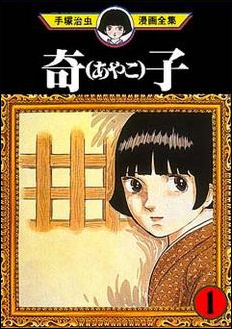
Tom Baker wrote in the Daily Yomiuri,”The end of World War II brought no end to the misery of the Tenge clan. In the opening scene of Osamu Tezuka's manga “Ayako”, Jiro Tenge, a former prisoner of war who has lost an eye, gets a mixed reception upon his homecoming. His mother and his sister Naoko seem glad to see him, but his father, Sakuemon, is angry that he failed to die and was captured instead.” [Source: Tom Baker, Daily Yomiuri, February 4, 2011]
“Sakuemon is no patriot. As the head of a decaying (and presumably fictional) aristocratic family that long controlled a rural section of Aomori Prefecture, he could have used a dead son to shore up his prestige. And a smaller family would have made it easier to manage his estate, greatly diminished since the Occupation authorities broke up major agricultural landholdings and parceled them out to former tenant farmers.”
“Sakuemon is a sexual predator who in his younger days enjoyed a kind of droit du seigneur among the local womenfolk. In recent years he has been reduced to extorting favors from his daughter-in-law by threatening to disinherit her husband, Ichiro Tenge. Under their patriarch's baleful influence, other members of the family also become warped. The Tenge family history is a swirling cesspool of rape, murder, incest and betrayal.”
“This is not Tezuka's only dark work, but for readers who know him mainly for cute creations, such as Astroboy or Kimba the white lion, Ayako will be a real eye-opener. Tezuka weaves his fictional family saga into the real-life tumult of Japan's postwar reconstruction. For example, he involves main character Jiro in a plot to murder the first president of Japan National Railways, Noriyuki Shimokawa, in circumstances modeled on the mysterious 1949 death of the real-life first president of JNR, Sadanori Shimoyama. Tezuka even draws the fictional president's face to resemble that of the real one.”
“As always with a Tezuka manga, it is not just the complicated story but the well-thought-out artwork that makes Ayako worth reading. The title character, Jiro's half-sister, is the baby of the family, and becomes a scapegoat for the other family members' sins. One way Tezuka illustrates this idea is to show a full page of non-rectangular panels, resembling irregular panes of a stained-glass window, where various family members are depicted in words and pictures. These relatively large panels surround one small panel in the center of the page, where little Ayako sits alone in the darkness, with no accompanying text.”
“At this point in the story, the family has condemned Ayako to imprisonment in a pit — literally — to keep her from revealing a crime she has witnessed. Befitting the subject matter, Tezuka often uses film noir effects on his pages, filling them with shadows and strange viewing angles. When a man tries to rescue Ayako from the pit, after she has been in it so long that she is afraid to leave, Tezuka gives us another full page of nonrectangular panels. Their jagged shapes are filled with exaggerated perspectives as the man reaches down to her, well conveying her feeling of panic. Many mysteries arise in the course of this long and multistranded story, and Tezuka provides clear solutions to only a couple of them. But the telling of this twisted tale is so stylish and intriguing that it doesn't really matter.”
Image Sources: Tezuka English fan site, YouTube, Japan Zone, Wikipedia
Text Sources: New York Times, Washington Post, Los Angeles Times, Daily Yomiuri, Times of London, Japan National Tourist Organization (JNTO), National Geographic, The New Yorker, Time, Newsweek, Reuters, AP, Lonely Planet Guides, Compton’s Encyclopedia and various books and other publications.
Last updated August 2011
